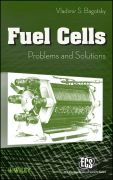
The book extracts the most important information on fuel cells, analyzes thisinformation, and assesses its scientific value and technical importance. It provides a full yet concise description of all important aspects of fuel cells.The introduction establishes both what a fuel cell is and its economic significance. The book then discusses how a fuel cell works, its history, types of cells, problems, applications, and its place and outlook. This is an ideal presentation of fuel cell technology for advanced undergraduate and graduate students in multiple scientific fields, including engineering and chemistry. INDICE: PART I: INTRODUCTION. What is a fuel cell? - Definition of the term. Significance of fuel cells for the economy. Chapter 1: The working principle of a fuel cell. 1.1 Thermodynamic aspects. 1.2 Schematic layout of fuel cellunits. 1.3 Types of fuel cells. 1.4 Layout of a real fuel cell: the hydrogen-oxygen fuel cell with liquid electrolyte. 1.5 The basic parameters of fuel cells. Chapter 2: The long history of fuel cells. 2.1 The period prior to 1894. 2.2 The period from 1894 to 1960. 2.3 The period from 1960 to the 1990s. 2.4 The period after the 1990s. PART II: MAJOR TYPES OF FUEL CELLS. Chapter 3: Proton exchange membrane Fuel Cells (PEMFC). 3.1 The history of PEMFC. 3.2 StandardPEMFC version of the 1990s. 3.3 Special features of PEMFC operation. 3.4 Platinum catalyst poisoning by traces of CO in the hydrogen. 3.5 Commercial activities in relation with PEMFC. 3.6 Future development of PEMFC. 3.7 Elevated temperature PEMFC (ET-PEMFC). Chapter 4: Direct Liquid Fuel Cells (DLFC). Part A:Direct Methanol Fuel Cells (DMFC). 4.1 Methanol as fuel for fuel cells. 4.2 Current-producing reaction and thermodynamic parameters. 4.3 Anodic oxidation of methanol. 4.4 Milestones in DMFC development. 4.5 Membrane penetration by methanol (methanol crossover). 4.6 Varieties of DMFC. 4.7 Special operating features of DMFC. 4.8 Practical models of DMFC and their features. 4.9 The problems to be solved in future DMFC. Part B: Direct Liquid Fuel Cells DLFC. 4.10 Theproblem of replacing methanol. 4.11 Fuel cells using organic liquids as fuels. 4.12 Fuel cells using inorganic liquids as fuels. Chapter 5: Phosphoric acidFuel Cells (PAFC). 5.1 Early work on phosphoric acid fuel cells. 5.2 The special features of aqueous phosphoric acid solutions. 5.3 Construction of PAFC. 5.4 Commercial production of PAFC. 5.5 Development of large stationary power plants. 5.6 What future for PAFC? 5.7 Importance of PAFC for fuel cell development. Chapter 6: Alkaline Fuel Cells (AFC). 6.1 Hydrogen-oxygen AFC. 6.2 Alkaline hydrazine fuel cells. 6.3 Anion-exchange (hydroxyl ion conducting) membranes. 6.4 Methanol fuel cells with anion-exchange membranes. 6.5 A methanol fuel cell with an invariant alkaline electrolyte. Chapter 7: Molten carbonate fuel cells (MCFC). 7.1 The special features of high-temperature fuel cells. 7.2 The structure of hydrogen-oxygen MCFC. 7.3 MCFC with internal fuel reforming. 7.4 The development of MCFC work. 7.5 The lifetime of MCFC. Chapter 8: Solid oxideFuel Cells (SOFC). 8.1 Schematic design of conventional SOFC. 8.2 Tubular SOFC. 8.3 Planar SOFC. 8.4 Monolithic SOFC. 8.5 Varieties of SOFC. 8.6 The utilization of natural fuels in SOFC. 8.7 Interim-temperature SOFC (IT-SOFC). 8.8 Low-temperature SOFC (LT-SOFC). 8.9 Factors influencing the lifetime of SOFC. Chapter 9: Other Fuel Cells. 9.1. Redox flow cells. 9.2 Biological fuel cells. 9.3 Semi-Fuel Cells. 9.4 Direct carbon fuel cells (DCFC). Chapter 10: Fuel cells and electrolysis processes. 10.1 Water electrolysis. 10.2 Chlor-alkali electrolysis. 10.3 Electrochemical synthesis reactions. PART III: INHERENT SCIENTIFIC AND ENGINEERING PROBLEMS. Chapter 11: Fuel management. 11.1 Reforming of natural kinds of fuel. 11.2 Production of hydrogen for autonomous power plants. 11.3 Purification of technical hydrogen. 11.4 Hydrogen transport and storage. Chapter 12: Electrocatalysis. 12.1 What is electrocatalysis ? 12.2 Putting Pt catalysts on the electrodes. 12.3 Supports for platinum catalysts. 12.4 Platinum alloys and composites as catalysts for anodes. 12.5 Non-platinum catalysts for fuel cell anodes. 12.6 Electrocatalysis of the oxygen reduction reaction (ORR). 12.7 The stability of electrocatalysts. Chapter 13: Membranes. 13.1 Fuel-cell-related membrane problems. 13.2 Work to overcome degradation of Nafion membranes. 13.3 Modification of Nafion-type membranes. 13.4 Membranes made frompolymers without fluorine. 13.5 Membranes made from other materials. 13.6 Matrix-type membranes. 13 7 Membranes with hydroxyl ion conduction . Chapter 14: Small fuel cells for portable devices. 14.1 Special operating features of mini-fuel cells. 14.2 Flat mini-fuel batteries. 14.3 Silicon-based mini-fuel cells. 14.4 PCB-based mini-fuel cells. 14.5 Mini-solid oxide fuel cells. 14.6 The problem of air-breathing cathodes. 14.7 Prototypes of power units with mini-fuel cells. 14.8 Concluding remarks. Chapter 15: Mathematical modeling of fuel cells (Felix N. Büchi). 15.1 0-dimensional models. 15.2 1-dimensional models. 15.3 2 dimensional models. 15.4 3 dimensional models. 15.5 Concluding remarks . PART IV: COMMERCIALIZATION OF FUEL CELLS. Chapter 16: Applications. 16.1 Largestationary power plants. 16.2 Small stationary power units. 16.3 Fuel cells for transport applications. 16.4 Portables. 16.5 Military Applications. Chapter17: Fuel cell work in various countries. 17.1 Driving forces for fuel-cell work. 17.2 Fuel cells and the hydrogen economy. 17.3 Activities in North America. 17.4 Activities in Europe. 17.5 Activities in other countries. 17.6 The volume of published fuel-cell work. 17.7 Legislation and standardization in the field of fuel cells. Chapter 18: Outlook. 18.1 Alternating periods of hope and disappointment forever? 18.2 Some misconceptions (Klaus Müller). 18.3 "Ideal fuel cells" do exist. 18.4 Expected future situation of fuel cells.
- ISBN: 978-0-470-23289-7
- Editorial: John Wiley & Sons
- Encuadernacion: Cartoné
- Páginas: 320
- Fecha Publicación: 17/02/2009
- Nº Volúmenes: 1
- Idioma: Inglés
